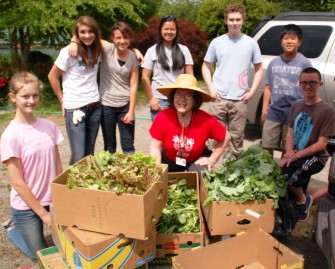Coordinating Volunteers
Gleans are often hard to predict and therefore difficult to plan ahead of time. The best way to manage your volunteers is usually through an email listserv. This way, every time there is a new opportunity you can quickly share information out to all volunteers without wasting time calling people. There are many different websites available for creating email lists online.
Harvest for Hope made a Google Group in order to keep in contact with our volunteers. Anyone that joins the group gets all emails that are sent to the group. This system has worked fairly well, although there are a few disadvantages. It allows everyone to communicate with each other, so volunteers can see how many people have already responded to a glean announcement. This can be a down side for some though, as it means more emails. Further, you have no way of checking to see if people are reading the emails you send out, which some other listservs can allow.
When sending emails to volunteers keep a similar format from email to email. This will save volunteers time when reading emails, and mitigate frustration if they get a lot of emails in a small amount of time. The email should include bullet points, which can be quickly scanned. An example of what to include is below.
1. Date
2. Time
3. Address
4. Farm
5. Produce
6. Special Instructions
In the first year of our program we had a limited number of volunteers. In order to cope with our smaller volunteer base, an email was sent out asking volunteers to respond when they were available. Gleans were then scheduled around these times to include the ideal number of volunteers. Although this can create more emails, it is one of the best options when your volunteer base is smaller in size.
Once you have this listserv you can use it for other purposes than just announcing gleans. You can use it to send out program newsletters or thank you notes to volunteers for helping.
Volunteer Appreciation
 Showing thanks to your volunteers is extremely important. Food recovery programs rely heavily on volunteers to work, and if you want volunteers to keep coming back you need to show them how important they are. There are many ways to do this, which includes, but is not limited to:
Showing thanks to your volunteers is extremely important. Food recovery programs rely heavily on volunteers to work, and if you want volunteers to keep coming back you need to show them how important they are. There are many ways to do this, which includes, but is not limited to:
-
Thank you emails/cards
-
T-shirts or buttons
-
Newsletters highlighting volunteers
-
End of season gathering with volunteers
At the end of each month with our program we send out an email called Volunteer Appreciation. In this email the volunteers are thanked for their help, told how many hours they have put in, how much food was gleaned, and the volunteers with the most number of hours.
Volunteers Taking Food
Whether or not you let volunteers take some food they have gleaned is a decision to be made by the program developers. This can be a great incentive for volunteers to come out and help, and is another way of showing your appreciation for the time they are giving. However, it is important to establish clear expectations from the onset if volunteers take gleaned food. Usually this just consists of letting them know they should only take what they will definitely use. This choice must also take the donor’s wishes into account.

.png ) It is important before volunteers start gleaning that they have a clear sense of what to expect and what is expected of them. Making handouts that give them clear instructions helps insure gleaning runs smoothly, and you do not cause any problems that will lose the trust of the grower. Sample information handouts are below.
It is important before volunteers start gleaning that they have a clear sense of what to expect and what is expected of them. Making handouts that give them clear instructions helps insure gleaning runs smoothly, and you do not cause any problems that will lose the trust of the grower. Sample information handouts are below. Showing thanks to your volunteers is extremely important. Food recovery programs rely heavily on volunteers to work, and if you want volunteers to keep coming back you need to show them how important they are. There are many ways to do this, which includes, but is not limited to:
Showing thanks to your volunteers is extremely important. Food recovery programs rely heavily on volunteers to work, and if you want volunteers to keep coming back you need to show them how important they are. There are many ways to do this, which includes, but is not limited to: